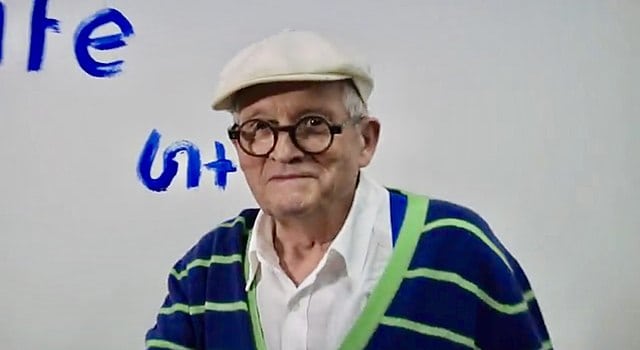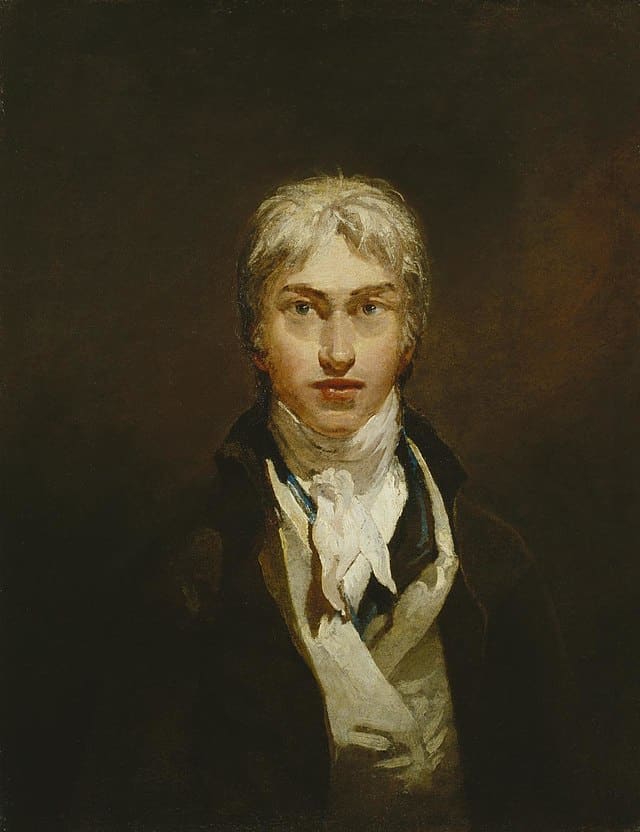
Photo by Connaissance des Arts – Wikimedia
10 Most Famous British Painters
The history of British painting is intimately linked with the broader traditions of European painting. Kings and queens commissioned portraits from German, Dutch, and Flemish artists.
Holbein, Van Dyck, and other eminent foreign portraitists imparted an aura of grandeur to even their most unimposing sitters.
Most of the British famous painters include Lucien Freud, David Hockney, William Hogarth, Joshua Reynolds, Thomas Gainsborough, John Constable, Joseph Mallord William Turner, John Everett Millais, Alfred Sisley, and Francis Bacon.
1. William Hogarth
He was born on November 10, 1697 in London, UK. He died on October 26, 1764. He was the first English-born artist to attract admiration abroad and was best known for his moral and satirical engravings and paintings.
He established his drawing school on a cooperative basis after Thornhill’s death in 1734. He is best known for his paintings of modern moral subjects.
He started to produce his own engraved designs in about 1710 and later took up oil painting, starting with small portrait groups called conversation pieces.
He produced a work entitled Sigismunda Mourning over the Heart of Guiscardo in 1759.
2. Joshua Reynolds
He was an English painter specializing in portraits. He was born on July 16, 1723, at Plympton, Plymouth, UK. He died on February 23, 1792, in Richmond, UK.
He combined the English style of portraiture with ideas drawn from antiquity and the Old Masters to create fashionable, large-scale images of British high society as well as early celebrities including actors and courtesans.
His images often included theatrical elements, colorful props and costumes, imagined pastoral landscapes, and irreverent classical symbolism.
He played a central role in the founding of the Royal Academy of Arts which gave artists an opportunity to display their work publicly.
3. Thomas Gainsborough

Photo by Wikimedia commons – Wikimedia
He was an English portrait and landscape painter, a designer, and a print maker. He was born on May 14, 1727, in Sudbury UK. He died on August 2, 1788, in London UK.
His words echoed the luxury and leisure of aristocratic society through contemporary fashion.
His most influential works were one’s idealized pastoral life in the rural countryside. He exerted powerful sway over the British School of Painting through his exceptional abilities and passion for landscapes.
One of the earliest artists to have conveyed a statement against urban development via a retreat into nature through a landscape painting. One of his discoveries of a study sketch in 2017 was one of the 26 drawings in the Royal Collection at Windsor Castle.
4. David Hockney

Photo by Connaissance des Arts – Wikimedia
He was born on July 9, 1937, in Bradford, UK. He is an English painter, draftsman, printmaker, stage designer, and photographer.
His best-known artwork is A Bigger Splash painted in 1967. The painting depicts a sun-drenched swimming pool in Los Angeles.
Behind the pool are a pink modernist building and an empty chair. The silhouettes of neighboring buildings are reflected in the building’s large window.
Another painting of him is A Promised Land and The Splash in Focus. He used acrylic paint and drew images on the canvas first but painted the blocks of color directly to it.
5. John Constable

Photo by Stephencdickson – Wikimedia
He was born on June 11, 1776, in East Bergholt, UK. He was an English landscape painter in the Romantic tradition. He died on March 31, 1837, in London, UK.
The revolutionized landscape printing were first seen in the 19th century through his paintings which had a profound far-reaching effect on European art, particularly in France.
He is mostly remembered for his bucolic images painted in and around the Stour Valley. He sketched the changing patterns of clouds, weather, and light in his oil sketches.
He worked with a large, loose brushstroke to create expressive representations which represented an overall sense of what he saw.
He utilized color more widely than the norm reflecting on hues he found in nature. He is particularly known for his unique addition of pure white highlights which served to represent the sparkle of light on water.
6. Joseph Mallord William Turner

Photo by J. M. W. Turner – Wikimedia
He was born on April 23, 1775, at Convent Garden, London, UK. He died on December 19, 1851, at Cheyne Walk, London, UK.
His works earned him the best-loved English Romantic artist. He is also known as the painter of light due to his increasing interest in brilliant colors as the main constituent of his landscapes and seascapes.
7. John Everett Millais

Photo by National Portrait Gallery – Wikimedia
He was born on June 8, 1829, in Southampton, UK. He died on August 13, 1896, at Kensington, London, UK.
He was first Baronet, an English painter, illustrator, and one of the founder members of the Pre Raphaelite Brotherhood.
Mariana is a painting that Millais painted in 1850 and 1851 based on the play Measure for Measure by William Shakespeare and the poem of the same name by Alfred, Lord Tennyson from 1830.
In the play, the young Mariana was to be married but was rejected by her betrothed when her dowry was lost in a shipwreck. By the late 1850s, Millais was becoming more and more versatile, even using his art to make political statements.
He also began to practice using his own children as models. He soon gained widespread recognition for his ability to capture the essence of childhood, receiving several commissions for children’s portraits.
8. Alfred Sisley
He was on born October 30, 1839, in Paris, France. He was an Impressionist landscape painter who was born and spent most of his life in France but retained British citizenship.
Sisley was essentially a landscape painter. His early style was much influenced by Camille Corot, and his restricted and delicate palette continued to reflect something of Corot’s silvery tonalities.
Sisley’s landscapes are known for their uncanny ability to capture a sense of atmosphere and light. This effect is compounded by his big, expressive skies, which are almost always a central feature of his paintings.
9. Francis Bacon
He was born on October 28, 1909, in Dublin, Ireland. He was a British figurative painter known for his raw, unsettling imagery.
Focusing on the human form, his subjects included crucifixions, portraits of popes, self-portraits, and portraits of close friends, with abstracted figures sometimes isolated in geometrical structures.
Borrowing inspiration from Surrealism, film, photography, and the Old Masters, he forged a distinctive style that made him one of the most widely recognized exponents of figurative art in the 1940s and 1950s. Bacon concentrated his
energies on portraiture, often depicting habitués of the bars and clubs of London’s Soho neighborhood.
His subjects were always portrayed as violently distorted, almost slabs of raw meat, that are isolated souls imprisoned and tormented by existential dilemmas. He died on April 28, 1992, in Madrid, Spain.
10. Lucien Freud
He was a British painter and a Designer specializing in figurative art and is known as one of the foremost 20th century English portraits.
He was born on December 8, 1922, in Berlin Germany. He died on July 20, 2011, in London, UK. His career was influenced by surrealism. He was an intensely guarded and private man and his paintings were mostly of friends and family.
His paintings are somber and thickly imposed, often set in unsettling interiors and urban landscapes. His artworks are noted for their psychological penetration and discomforting examination of the relationship between artist and model.
He painted fellow artists including Frank Auerbach and Francis Bacon. He also painted a nude portrait of model Kate Moss.
British painters made a big impact in changing the course of painting’s history. These famous British artists were among the first to start painting experiences and visions rarely ever painted before.
Some of the most important innovations included an introduction to the new understanding of the human body and redefinition of the space as demonstrated by Francis Bacon.
Planning a trip to Paris ? Get ready !
These are Amazon’s best-selling travel products that you may need for coming to Paris.
Bookstore
- The best travel book : Rick Steves – Paris 2023 – Learn more here
- Fodor’s Paris 2024 – Learn more here
Travel Gear
- Venture Pal Lightweight Backpack – Learn more here
- Samsonite Winfield 2 28″ Luggage – Learn more here
- Swig Savvy’s Stainless Steel Insulated Water Bottle – Learn more here
Check Amazon’s best-seller list for the most popular travel accessories. We sometimes read this list just to find out what new travel products people are buying.









